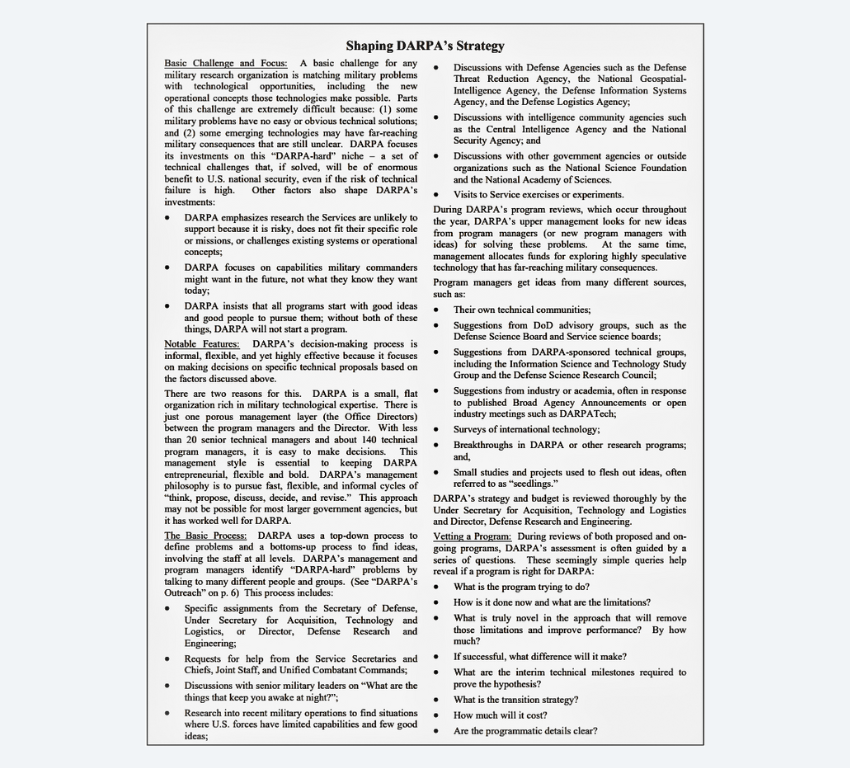Quantive is now part of WorkBoard. Get to know WorkBoard:
How DARPA tackles defense challenges is a masterclass in strategy — one that any leader can learn from. When we talk about strategy, we almost always think of business. Numerous articles analyze how Apple, Netflix, Google, and Microsoft rose to market dominance. Everyone wants to crack the code behind their success.
But have you ever looked to military strategy for answers?
Steve Jobs was inspired by Sun Tzu’s The Art of War to maintain secrecy and build anticipation around Apple’s product launches.
Jeff Bezos applied military logistics principles to revolutionize supply chain management, ensuring strategic resource allocation and positioning.
Reed Hastings understood the market's "terrain" and invested in original content to gain a competitive edge.
These examples prove a simple truth:
“Some of the best strategic lessons come from the battlefield.”
And when it comes to strategy, military thinking is the original playbook.
The DARPA strategy use case
At Quantive, we see strategic challenges as powerful drivers for innovation. DARPA (Defense Advanced Research Projects Agency), a premier research agency in the U.S. Department of Defence, represents a shining example of successful strategy both in development and execution.
Their approach aligns closely with Richard Rumelt's Kernel framework, which emphasizes defining the challenge, setting guiding policies, and taking coordinated actions, as reported in a previous article.
The Defense Advanced Research Projects Agency (DARPA) is an agency of the United States Department of Defense (DoD) responsible for developing emerging technologies for military use. Established in 1958 in response to the Soviet Union's launch of Sputnik, DARPA’s mission has always been to prevent technological surprises that could threaten U.S. national security while creating strategic advantages through cutting-edge research and development.
DARPA’s strategy is publicly available and represents one of the best-written Strategies currently accessible to the public.

It is a simple “strategy one-pager” that is articulated across three parts:
- the challenge definition
- the guiding policy
- the coherent actions required to execute their strategy successfully
In this article, we will use the publicly available document to guide us through the three elements of the DARPA strategy.
Policies: Guiding strategic decision-making
DARPA’s strategy isn’t to tackle any problem but to pursue innovations that others won’t. This is not a general direction. Their strategy includes a specific guiding policy to direct everyday actions.
Their policies ensure their focus remains on solving high-stakes, high-reward problems while maintaining an entrepreneurial and flexible approach. To that extent, program managers are retained only for 4 to 6 years. This ensures a continuous influx of fresh talent with innovative ideas while preventing organizational silos and the concentration of power or influence within a single employee.
Key policies include:
- Focus on future capabilities: DARPA invests in capabilities military commanders might need in the future rather than current, known problems.
- Risk-taking and innovation: DARPA emphasizes projects that are too risky or challenging for traditional military branches.
- People and ideas first: DARPA starts programs only when both the technical idea and the people behind it are exceptional. As stated:
“DARPA insists that all programs start with good ideas and good people to pursue them; without both of these things, DARPA will not start a program.”
These guiding policies create the strategic guardrails that help DARPA prioritize its investments and maintain agility in its decision-making process. Their flat organizational structure enables rapid decision-making and flexibility, allowing them to adapt quickly and embrace innovation.
Coherent actions: Strategy implementation with precision
The final element focuses on actions — specific steps organizations take to implement their strategy following their guiding policy. DARPA’s strategic actions are centered around a robust yet flexible approach to identifying and solving complex technical challenges. Their decision-making and strategy execution are driven by continuous exploration and iteration.
DARPA’s management approach is defined as:
“Fast, flexible, and informal cycles of ‘think, propose, discuss, decide, and revise.’”
This iterative, bottom-up approach to developing solutions allows DARPA to constantly adapt, experiment, and refine its projects based on emerging opportunities or changing needs. Its program managers source ideas from diverse stakeholders, including the military, industry, academia, and advisory groups, ensuring it remains at the forefront of cutting-edge technology.
Furthermore, their focus on vetting programs rigorously ensures that every project aligns with DARPA's strategic goals:
"What is the program trying to do? How is it done now, and what are the limitations? What is truly novel in the approach that will remove those limitations and improve performance?"
DARPA's strategy is an obvious example of a good strategy that operates as a lever to tackle complex challenges, align organizational policies, and execute with agility.
Applying DARPA’s strategy principles with Quantive StrategyAI
DARPA’s success in overcoming strategic challenges is the perfect example of implementing the Kernel of Strategy, which allows any organization to innovate quickly and scale.
With Quantive StrategyAI, we enable organizations to apply these same principles in a business context:
- Define the challenge: Quantive StrategyAI helps organizations identify and frame strategic challenges using AI-powered insights and strategic analysis. This enables you to focus only on the most critical and high-impact problems.
- Guiding policies: Quantive StrategyAI provides goal alignment, real-time strategic performance tracking, and AI-powered strategic recommendations to ensure execution stays relevant to the current market conditions.
- Coherent actions: Every strategy needs strong execution to succeed. Quantive StrategyAI equips teams with OKRs, KPI tracking, and adaptive strategy management tools to execute with agility, iterate continuously, and stay ahead of disruption.
While DARPA operates in national security, businesses face their own version of "DARPA-hard" challenges. The complex, high-stakes problems require a combination of foresight, flexibility, and execution discipline.
With Quantive StrategyAI, organizations can adopt a DARPA-like approach to strategy — using real-time insights, dynamic strategy execution, and AI-driven adaptability to drive continuous innovation and competitive advantage.
Ready to turn strategy into action with the precision of DARPA? Let’s talk.






